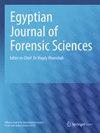马来西亚国民大学医疗中心尸检病例的耳部生物特征研究
IF 1.3
Q3 MEDICINE, LEGAL
引用次数: 0
摘要
根据对活人耳部生物特征的地标性变化的识别,耳朵越来越被认为是法医学的辅助工具之一。然而,还没有对死者进行过此类比较的可靠性研究。本研究旨在调查耳部生物测定与死者年龄、性别和身材之间的相关性。研究对象是马来西亚国民大学医疗中心法医股收到的 181 名死者,年龄在 18 至 70 岁之间。研究人员记录了死者的年龄、性别、种族和身高,并拍摄了双耳照片。根据 Iannarelli 方法测量了 12 个耳部生物特征,并从照片中测量了耳长和耳宽。结果显示,男性和女性在六项耳部生物测量指标上存在显著差异。耳部生物统计学指标,即耳长和耳宽与个人的年龄和身高之间也存在明显的相关性。简而言之,男性和女性在耳部生物统计学方面存在明显差异,耳部生物统计学与个人身高和年龄之间存在良好的相关性。因此,在法医领域,耳朵可用于个人身份鉴定。本文章由计算机程序翻译,如有差异,请以英文原文为准。
A study of ear biometrics in autopsied cases at the Universiti Kebangsaan Malaysia Medical Centre
The ears have increasingly been recognized as one of the supportive tools in forensics, based on the identification of landmark variations of ear biometrics in living persons. However, no studies on the reliability of such comparisons have been done on the deceased. The study aimed to investigate the correlation between ear biometrics and the age, sex, and stature of the deceased. The study was conducted on 181 deceased persons, aged between 18 and 70 years old on cases received by the Forensic Unit of Universiti Kebangsaan Malaysia Medical Centre. Documentation of age, sex, race, and height was recorded, and photographs of bilateral ears were taken. Measurements of twelve ear biometrics based on the Iannarelli method and ear length and ear width were taken from the photographs. Results showed that there was a significant difference between males and females in six ear biometrics. There was also a significant correlation between ear biometrics, that is, ear length and ear width with the age and height of an individual. In brief, there exists a significant difference between males and females in ear biometrics with good correlations between ear biometrics and the height and age of an individual. Hence, the ear can be used for personal identification in the forensic field.
求助全文
通过发布文献求助,成功后即可免费获取论文全文。
去求助
来源期刊

Egyptian journal of forensic sciences
MEDICINE, LEGAL-
CiteScore
2.00
自引率
0.00%
发文量
51
审稿时长
17 weeks
期刊介绍:
Egyptian Journal of Forensic Sciences, the official publication of The International Association of Law and Forensic Sciences (IALFS), is an open access journal that publishes articles in the forensic sciences, pathology and clinical forensic medicine and its related specialities. The journal carries classic reviews, case studies, original research, hypotheses and learning points, offering critical analysis and scientific appraisal.
 求助内容:
求助内容: 应助结果提醒方式:
应助结果提醒方式:


